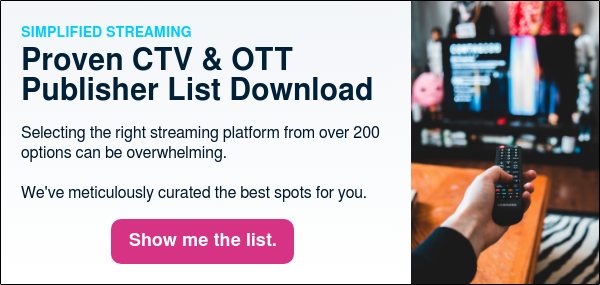Linear TV is dying. Recent research shows that 88% of US households have video streaming services compared to only 50.8% with linear TV.
Over-the-top (OTT) and Connected TV (CTV) are the new frontiers for marketers looking to reach cord-cutters and digital-savvy consumers in the age of streaming.
As more viewers move away from traditional linear TV, advertisers can use OTT and CTV to reach new audiences in micro-targeted, measurable, and cost-effective ways.
In this article, we’ll review the differences between OTT, Linear TV, and CTV, the benefits of using OTT and CTV advertising, and which options might be better suited for your business needs.
What is cord-cutting?
The rise of CTV and OTT has led to “cord-cutting,” the practice of canceling or forgoing a traditional cable or satellite TV subscription in favor of streaming video content over the internet.
Cord cutters typically rely on Over-the-top (OTT) platforms, such as Netflix, Hulu, Amazon Prime Video, and other streaming services, to access their favorite TV shows, movies, and other video content.
What is Connected TV (CTV)?
A connected TV (CTV), or smart TV, is a TV or TV plug-in device equipped with internet connectivity and can access online content, streaming services, and other digital media.
With CTVs, you can access a wide range of internet-based video content, like TV shows, movies, and live events, through apps or platforms installed directly on the TV.
Some examples of CTVs include:
- Roku
- Apple TV
- Amazon Fire
- Smart TVs like Samsung, LG, and Sony
CTVs are televisions with integrated internet capabilities but exclude other types of devices such as smartphones, tablets, and desktops.

Smart TVs like this one from Sony allow you to stream movies directly from the TV using an internet connection.
📚 Related Article: Interactive CTV Ads are the Secret to Higher Engagement and Longer Viewing Rates: Read more about how interactive CTV ads can complement your OTT/CTV strategy.
What is Over-The-Top (OTT)?
Over-the-top (OTT) is the direct delivery of digital media content over the internet to viewers, bypassing traditional broadcast or cable distribution methods.
Viewers can access OTT services through apps or platforms on various devices like smartphones, tablets, smart TVs, and streaming devices.
Examples of popular OTT video streaming services are
- Netflix (231 million subscribers)
- Hulu (47.2 million subscribers)
- Amazon Prime Video (>200 million subscribers)
- Disney+ (161.8 million subscribers)
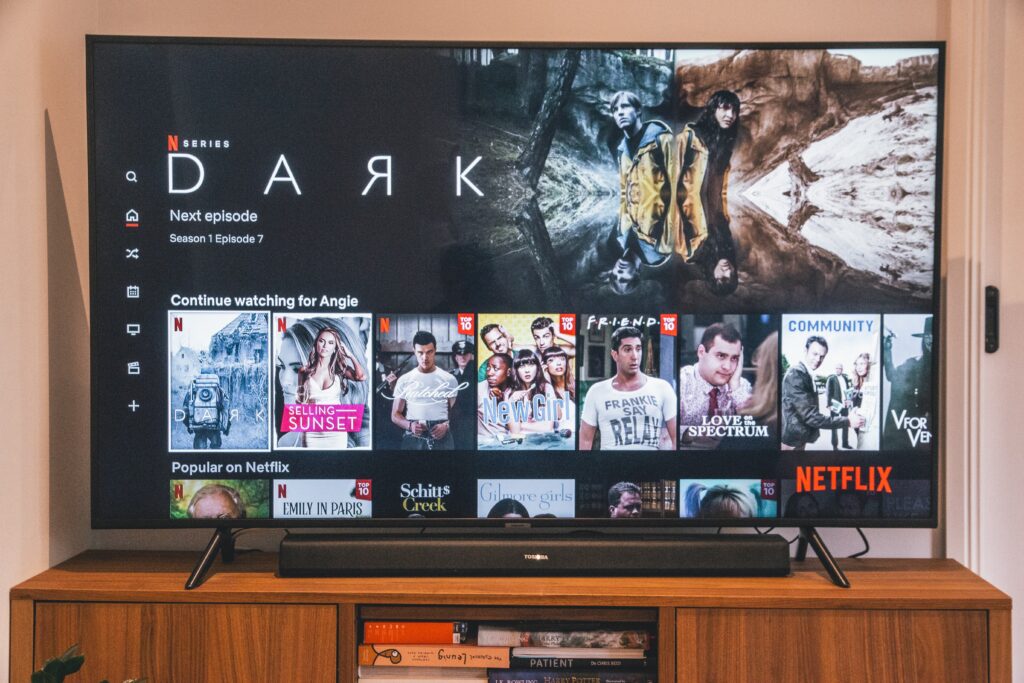
Netflix is an example of an OTT streaming service.
📚 Related Article: Act FAST with FAST Advertising: What It Is & Why You Need It: Discover how FAST (Free ad-supported TV) is growing amid rising subscription costs.
What is Linear TV?
Linear TV delivers traditional broadcast television programming through scheduled programming and restricts viewers from watching only the current programs without the ability to pause, rewind, or fast forward through them.
Linear TV can be received through an antenna, cable, or satellite TV provider.
Some examples of linear TV channels include:
- ABC
- NBC
- CBS
- Fox

What’s the difference between CTV, OTT, and Linear TV?
Marketers often use OTT and CTV interchangeably, but they’re not the same thing. Viewers can access streaming content through OTT, while CTV provides the display platform.
What’s the difference between OTT vs CTV?
“Think of OTT as the electrical grid that delivers power, and CTV as the appliance that uses power to bring light or entertainment to the viewer. The electrical grid is the method for delivering the power (OTV), and the appliance (CTV) being the device that brings the end product to the viewer. OTT is the content itself, and CTV is the real-time distribution vehicle. You can’t have one without the other.”

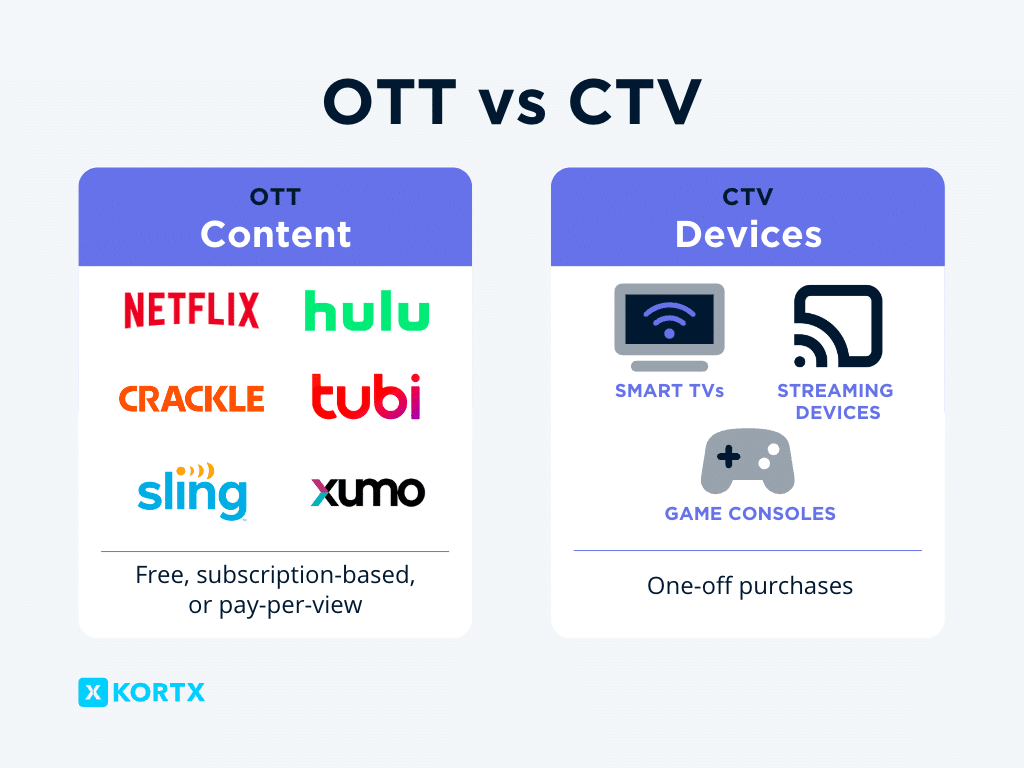
Any device with a screen and internet connection can stream OTT content, which is pulled directly from the internet, while a CTV is a TV (or a TV plug-in device) that can connect to the internet.
Linear TV is similar to OTT because while Linear TV explains how content is delivered, CTV refers to where it is delivered.
Example: if you want to watch White Lotus, you might turn on your smart TV (CTV), open up the HBO Max app (OTT), and search for “White Lotus.”
If you’re watching Linear TV, whether it’s a dumb or smart TV (CTV), you can only view “White Lotus” during its scheduled live airing.
Again, a CTV is a TV connected to the internet, which can be a smart TV or a TV connected to a stick, box, or gaming console. CTVs can also stream Linear TV content because they can either:
- Connect to a cable box
- Receive Linear TV broadcasts through built-in tuners (without the need for an external device)
Example: If you want to watch a local news station airing a live evening news broadcast at a scheduled time on a specific channel, you can use your smart TV to connect to your cable or satellite provider and tune in to the correct channel to watch the live broadcast as it happens.
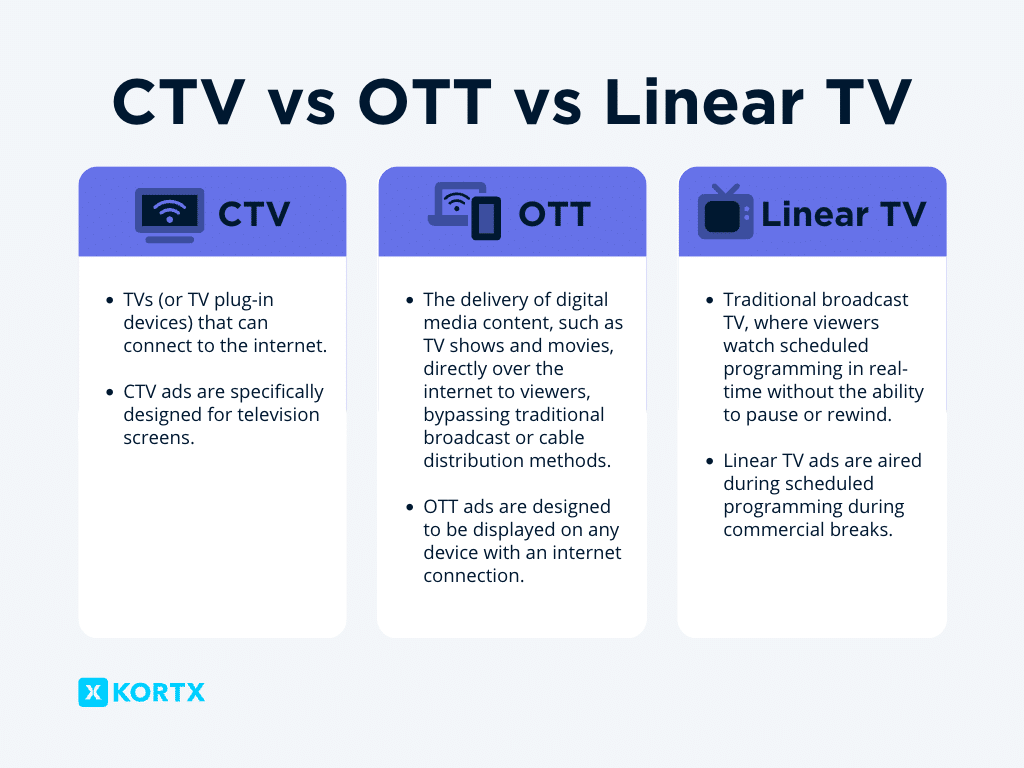
Now that we’ve covered the differences between OTT, CTV, and linear TV, let’s take a closer look at the benefits of advertising through OTT and CTV.
CTV vs Linear: What’s Better For Advertising?
“As the number of cord-cutters and cord-nevers continues to rise, CTV helps advertisers to increase their reach and hone in on their target audience. This ultimately creates more personalized experience for consumers that drives results.”

The Benefits of OTT and CTV Advertising
Hyper-personalized ad experience
Traditional Linear TV casts a wide net. While a considerable proportion of the population may view your ad, it may fail to engage all viewers due to the diverse demographics, leaving some to overlook your ads.
Although this Farmer’s Dog commercial pulled at the heartstrings for many viewers, viewers without a dog may not find an advertisement for dogs relevant or interesting, as they may not have a need or desire for that product.
OTT content offers addressable advertising through Third-Party audience targeting, customizing, and playing different ads for different viewers depending on their demographics and interests.
Addressable advertising allows advertisers to micro-target viewers for the maximum possible engagements.
Example: let’s say both an 85-year-old grandmother and a 25-year-old single grad student stream the same episode of “White Lotus.” An advertiser could hyper-personalize the viewing experience by showing completely different ads to the viewers, like sending an ad for a comfortable mattress to the grandmother and an ad for a Peloton to the college student.
Advertisers can use OTT advertisements to target particular demographics, including
- Age
- Gender
- Location
- Job title
- Education level
- Income
- Ethnicity
By using OTT, advertisers can precisely target their desired customers instead of employing a broad TV commercial approach, which is why it’s a logical choice for marketers.
A growing ad market
According to eMarketer, more than one-third of US households will have cut the cord by 2024. As more people opt to cancel their traditional TV subscriptions, advertising through OTT and CTV platforms can now effectively reach these audiences.
💥 Here’s proof of OTT’s strength with modern audiences:
- 87% of US households have at least one CTV device.
- 88% of US households have at least one OTT video service, with the average US consumer subscribing to at least four services.
- 50.8% of households subscribe to Linear TV, a number projected to decrease to only 40.2% by 2026.
- In 2023, US viewers will spend more than an hour and a half per day with subscription over-the-top (OTT) services.
OTT/CTV advertising also allows advertisers to target a younger demographic. Among young people, Linear TV viewership dropped by 23.4% from 2020-2021 for viewers aged 18-24 years old. And 12-17-year-olds represent the first generation more familiar with streaming content on CTVs rather than watching traditional TV.
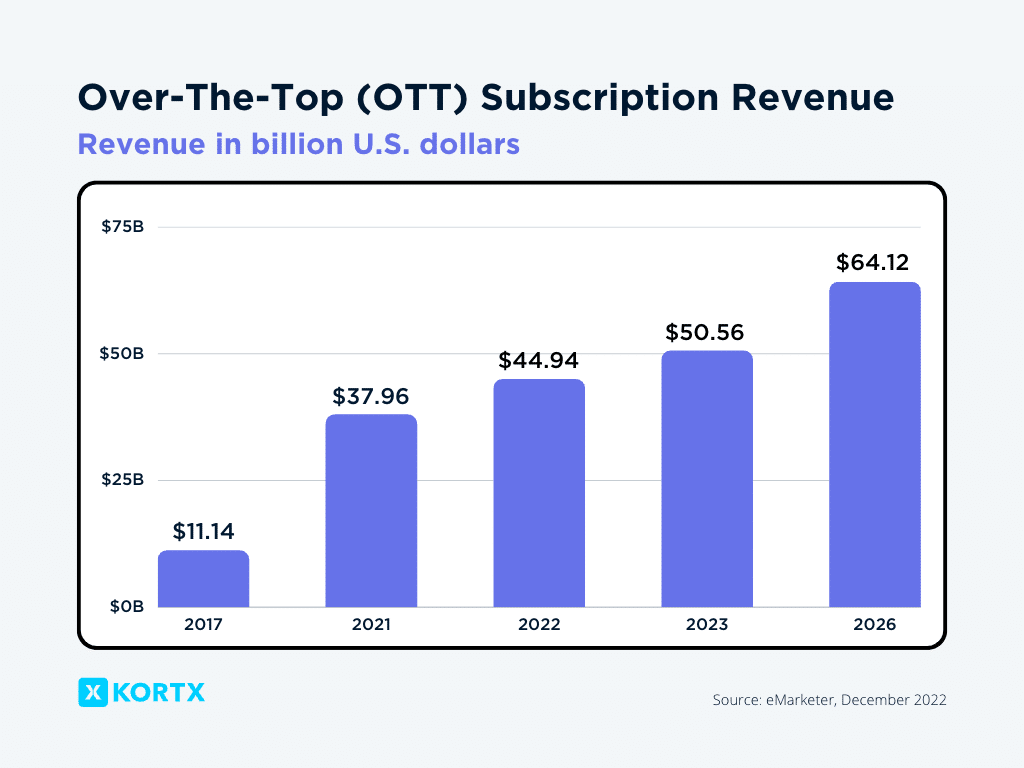
Overall, the increasing cord-cutting trend and the widespread adoption of CTV and OTT services among US households have made these platforms effective for advertisers to reach modern audiences, particularly the younger demographic who may be more familiar with streaming content on CTVs than traditional TV.
Ads on Netflix: Should you jump on the OTT bandwagon?
- Netflix’s ad-supported subscription launched in Nov 2022.
- As of Dec 2022, the ad tier is the least popular of all Netflix tiers.
- Targeting options are limited to country and content-based categories.
- No Third-Party segmentation or First-Party retargeting is available.
- Advertisements can be purchased through Xandr DSP with high seven-figure purchase minimums.
🎬 Read more about Netflix’s new ad-supported subscription in our Netflix Advertising Guide.
How to Measure CTV Advertising Effectiveness
OTT advertising offers many benefits, from targeting specific audiences to reaching viewers who have cut the cord on traditional TV.
However, like all forms of advertising, it’s important to measure its effectiveness to determine the return on investment.
There are two main methods to measure the effectiveness of OTT advertising:
- Video Completion Rate (VCR): How many times people finished watching the ad.
- Post-view attribution tracking: Connecting the viewership with completing an intended action like visiting a website, downloading an app, or going into a physical store.
VCR is the best measure of success because viewers must finish watching the ad before viewing the rest of their intended programming. In other words, because they’re forced to.
Example: let’s say you’re sitting on your couch, watching streaming content, and whether you’re pre-, mid-, or post-show, you’ll have to sit there and watch the ad because there’s no way to skip it. You must wait to get to the content. You can’t watch the full ad only if you turn off the service or device.
The other common measurement is post-view attribution tracking. As CTV/OTT ads are through streamed content, you can’t serve an ad with a CTA to say “click here to buy this product!”
However, you can serve a CTV ad for products viewers can buy. Even though they can’t click on the ad, they might see it and, three days later, search for it online and make the purchase.
How do advertisers measure an OTT/CTV campaign’s success?
“The most common metric for OTT/CTV is Video Completion Rate (VCR), and the industry benchmark is 90%+, with some getting into the high 90s. If a campaign is structured with more sophisticated site tagging, onsite actions or conversions can be attributed to an OTT/CTV ad exposure. Since users can’t click on CTV ads, it will be measured as post-view attribution (e.g. they saw the CTV ad and then later went to the brand’s site).”

The Future of OTT/CTV
As the technical capabilities of OTT/CTV continue to evolve, its future looks very promising, and the strategic approach will continue to deliver on three key points: functionality, measurement, and inventory.
Functionality
- QR codes: Bridging the gap between offline and online advertising, QR codes can drive traffic from a TV commercial to a landing page or other desired online destination.
- Overlays: Overlays can display a call-to-action (CTA) or message during an ad encouraging viewers to take a specific action, like visiting a website, making a purchase, or downloading an app.
- Picture-In-Picture (PiP): PiP allows viewers to continue watching video content while simultaneously viewing an advertisement, making it a less intrusive ad format.
Measurement
Digital marketers are turning to more sophisticated methods for evaluating CTV against metrics such as VCR.
Engagement with interactive creative elements, attribution against onsite page visits or actions, and external Third-Party solutions such as foot traffic or brand lift all provide more sophisticated CTV measurement capabilities that enable brands to assess the value of this media tactic within their holistic marketing plan.
Inventory
As linear viewership continues to decline, more and more platforms and studios are shifting their priorities to OTT platforms, where they can aggregate all of their content and reach a wider audience.
This trend has led to the availability of cinematic content, including streaming movies, on OTT platforms that are not likely to be released in theaters.
The growth of OTT platforms has provided a new avenue for TV/Movie content and advertisers to reach audiences. With increasing investment in OTT technology, it will only continue to grow.
📚 Related Article: 5 CTV Trends You Can’t Ignore: Learn more about the future of CTV advertising this year. You won’t want to miss out on CTV advertising from FAST streaming to interactive ads.
Cutting the Cord: Making Sense of OTT
As more households cut the cord on linear TV, OTT and CTV have become the new frontiers for marketers to reach digital-savvy consumers. While OTT is the direct delivery of digital media content over the internet, CTV is a television set equipped with internet connectivity and can access online content, streaming services, and other digital media. While they may be used interchangeably, OTT delivers content, while CTV provides the display platform for viewing it.
Traditional linear TV casts a wide net, which may not engage all viewers due to diverse demographics. By advertising on OTT and CTV, marketers can provide a more personalized ad experience, reaching specific demographics while still being able to cast a wider net.
📺 Engage your target audience on the biggest screen in the house.
Activate advanced audience targeting, increase your reach, and access premium audience inventory with KORTX’s CTV and Cross-Platform OTT solutions.
About the Author
Kate Meda is a Copywriter at KORTX. She enjoys omitting needless words and making things sound good.

